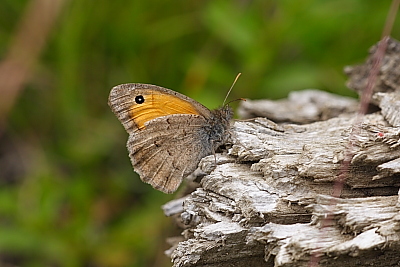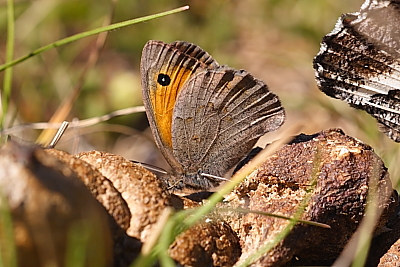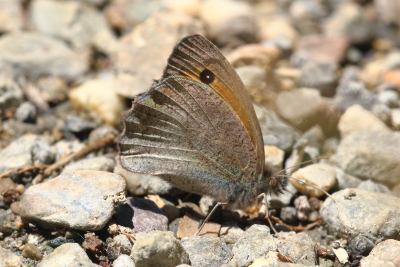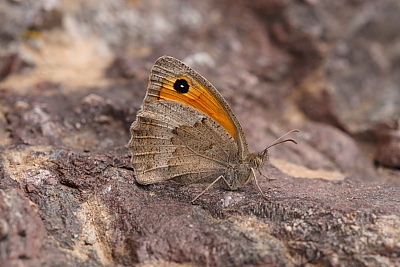



Oriental Meadow Brown (Hyponephele lupina)
2024 photographs highlighted in yellow. Click on any photograph to go to an enlarged picture, or simply scroll down the page.
 |
 |
 |
 |
| 27421_male_Hautes-Alpes_16Jul11 | 38343_male_Drôme_9Jul15 | 49676_male_Hautes-Alpes_7Jul22 | 27411_female_Hautes-Alpes_16Jul11 |
|
I am by no means certain that the two 2011 photographs on this page are of lupina. Expert opinion (from those that have seen lupina) seems divided. There are probably strong reasons why they are both lycaon, but there are major question marks, principally because they do not look like any Dusky Meadow Brown (H. lycaon) I have ever seen, and lycaon is encountered fairly regularly and its appearance is quite consistent in my experience. So I have placed them on a page for lupina in order to elicit comment and to ask the question: just what are the differentiating factors between lupina and lycaon?
Lupina is a butterfly with populations in Spain, North Africa, and Greece, with a few isolated colonies in south-eastern France. Lycaon has a wider distribution, extending across most of eastern Europe, most of Iberia, and most of south-eastern France. The flight periods of the two species are similar, being essentially July to mid-August, maybe lupina emerging a week or so earlier.
In the PACA region (Provence, Alpes, Côte d’Azur), there are very few recorded sightings of lupina, mostly in Var. It appears to be on the decrease because of habitat destruction. The two 2011 photographs were taken in the Hautes-Alpes where there are no recent records of lupina in the region where these two were seen, and the few historical records were some distance away. It is not impossible to find species in entirely new locations, but being some distance from any historical record reduces the probability greatly.
Both species tend to settle almost exclusively with wings closed, which is unfortunate in that identification would be straightforward with a sight of the upperside (of either sex), so the consideration here is focused solely on the underside. The uppersides of the females are quite different, and for the males, the shape of the upf androconial patch is characteristic and constant - see the illustrations in TLFr.
The sexes of both species are easily differentiated, principally because the females have two (larger) unf ocelli and the males only one.
These seem to be the main features that might determine identification (check links for the reference books):
unf ocelli: T&L shows the lycaon female unf s6 apical ocellus to be large and the ocellus in s2 to be only slightly smaller and to have a white centre. The lupina s2 ocellus is smaller than the s6 ocellus and blind. TLID quotes the ocelli as “large” for lycaon as compared to lupina.
unh discal line: T&L shows a clearly defined discal line in both sexes of lycaon, and a faint line for lupina. TLID shows two male lycaon, one with a weak discal line and no contrast across it, the other with a strong line and clear contrast. TLID says lupina is usually without a distinct discal line, lycaon has a distinct darker discal line often with darker submarginal shade. However, one of the lupina females clearly has darker submarginal shade but none of the other lupina or lycaon photographs have this. TLFr shows a female lycaon with a medium-weak discal line and a male with a vestigial line, while the male lupina has no discernible line or contrast. H&R says lycaon has a darker discal band, lupina “position of discal band often indicated by darker striae”. |
unh contrast across the discal line: T&L lycaon shows a clear contrast, with a distinctly lighter post-discal band.
unh colouring: T&L shows this as rather greyish or greyish-brown for lycaon and a slightly paler, cleaner, brown for lupina. TLID says lupina is pale grey-brown with thin darker irrorations, lycaon grey-brown. H&R says lycaon grey-brown, irrorated darker to pale-grey, lupina light grey-brown with fine darker irrorations.
unh “texture”: T&L shows lycaon having a rather rough texture, whereas lupina is smoother.
unh wing shape and scalloping: the lupina hindwing is distinctly more scalloped than lycaon, more so in the female. The female lupina hindwing is much squarer in shape in the T&L illustration. The PACA Atlas shows a photograph of a male with rather weak scalloping. TLID shows two female lupina, one of which has a weak discal line and strong scalloping, the other has a distinct discal line, albeit with limited contrast across it, and very limited scalloping. For lycaon, it shows two males, both of which have very limited scalloping
So what can we conclude, given that in several cases the identification features quoted were apparently in contradiction with the illustrations and photographs shown? The ocelli identification seems constant (although lycaon 3914 has a much smaller, blind, ocellus in s2, but the large s6 ocellus indicates lycaon). The discal line seems rather inconsistent, except that a strong discal line is more likely (perhaps always) indicative of lycaon, similarly for the contrast across the line; the absence of a discal line is not conclusive evidence of lupina. The colouring seems to be consistent in that greyer = lycaon, browner = lupina. Texture seems consistent that rough = lycaon, smooth(er) = lupina. Scalloping seems not at all consistent, except that heavy scalloping = lupina, especially in the female.
All that can definitively be concluded is that (as is so often the case), an upperside view is also required. A visit to the NHM archives was made in February 2012 to study the archives for lycaon and lupina: the results were rather inconclusive because nearly all specimens were of uppersides and, as such, matched the T&L illustrations quite closely. It had been hoped that there would be a sufficient number of undersides, but the collectors of yore always seemed to consider undersides as distinctly uninteresting. With regard to the degree of scalloping, this seemed to be inconsistent, with specimens of both species varying greatly. As the uppersides of pinned specimens are available to view, and these would be definitive for identification purposes, it can be assumed that the identifications were correct and therefore that scalloping is not a reliable differentiator. |
| ref | sex |
observations |
alt. m |
| 27421 | M | a male and looking completely different to any of the 30 or so photographs I have of lycaon, being much paler, browner and not having the characteristic roughness of lycaon. The discal line seems to match the H&R description “position of discal band often indicated by darker striae”. The apical ocellus is quite small, perhaps indicating lupina. I wonder if this is lupina, only in that there are good reasons for doubting it is lycaon. | 1330 |
| 38343 | M | I am reasonably confident that this is lupina, on the basis of the rather browner colouring, the relatively smooth texture, and the almost complete absence of a discal line or contrast across it. | 1220 |
| 49676 | M | I don't think there is any remaining doubt that this is male lupina. It helps that it was seen in a general area where it was known to occur | 1600 |
| 27411 | F | a female and may be more problematic. It looks to be a very fresh specimen, and has a very light brown colour with almost no hint of grey, and has a clean and smooth feel to it, not at all what I associate with lycaon. The hindwing shape is very square, also unlike any female lycaon I have seen, although the scalloping is not sufficiently deep as to indicate lupina (but see last paragraph in the narrative above). The discal line is strong with a very definite contrast across, and the ocellus is rather large; these features would almost certainly confirm lycaon, but maybe, as has been suggested, the lupina discal line can be stronger than previously thought. The doubt that 27411 is lycaon is exacerbated by the fact that it was seen in close proximity to 27421, which may of course not mean anything. Standard lycaon were flying a few kilometres away, looking very different to these two. | 1330 |
27421_male_Hautes-Alpes_16Jul11
49676_male_Hautes-Alpes_7Jul22
27411_female_Hautes-Alpes_16Jul11